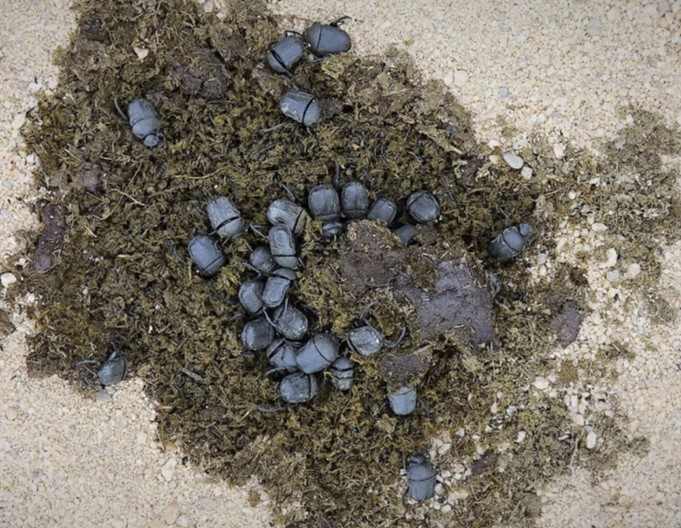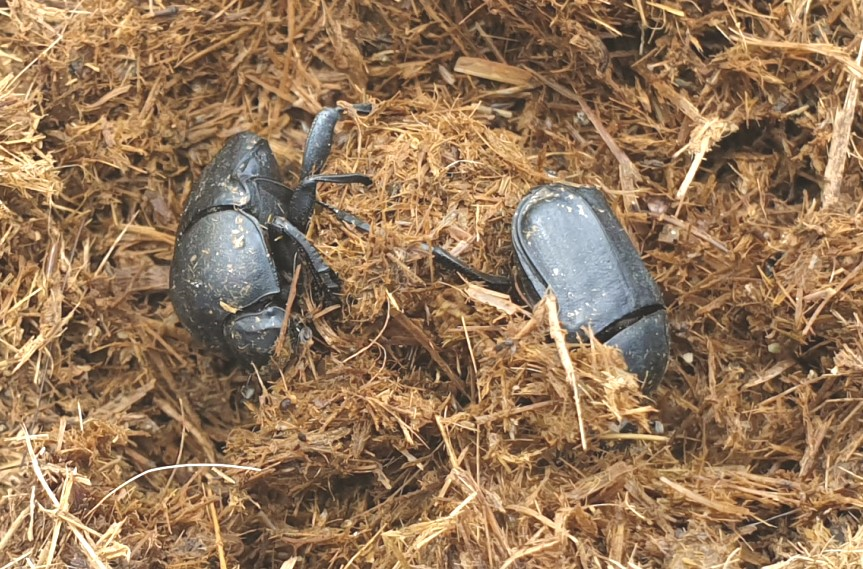'Will we get to see a scene of rolling poop?' Scarabs returns after 50 years of disappearance
- 남주원 기자
- 2023.09.15 17:57
The Korean news, reported and written by News Penguin journalist Hoo-rim Lee, has been translated and edited in English version by News Penguin journalist Joo-won Nam.

The critically endangered Scarabs(Gymnopleurus mopsus) has returned after half a century.
The Ministry of Environment and the National Institute of Ecology announced on the 13th that they released 200 endangered wild species class Ⅱ Scarabs in the Coastal Dune of Sinduri, Taean-gun, Chungcheongnam-do.
The release event involved various related organizations, including the Geum River Basin Environmental Office, Taean-gun, Korea National Park Service, and Cultural Heritage Administration, as well as students and residents from Mohang Elementary School in Taean-gun.
뉴스펭귄 기자들은 기후위기와 그로 인한 멸종위기를 막기 위해 헌신하고 있습니다.
정기후원으로 뉴스펭귄 기자들에게 힘을 실어 주세요.
이 기사 후원하기

Scarabs are coprophagy insects that feed on the excrement of large herbivorous animals such as cows, horses, and sheep. In the past, they were easily found throughout the Korean Peninsula, including Jeju Island. However, between the 1960s and 1970s, their population sharply declined, and it is currently estimated that they have become extinct in the wild. The causes of their extinction are attributed to changes in livestock farming environment from grazing to factory farming, the use of compound feed containing additives like antibiotics and preservatives, overuse of anthelmintics and pesticides, and habitat pollution.
Accordingly, the National Institute of Ecology has been working on the introduction of the original species of Scarabs from Mongolia since 2019. They have continued to develop artificial breeding technologies, conduct basic ecological research, determine optimal breeding conditions, and prepare guidelines for artificial breeding and research on its adaptability to the wild. As a result, 200 Scarabs were able to be multiplied and released into the natural environment in South Korea for the first time.
The researchers plan to confirm whether the released Scarabs can live in the actual ecosystem.

The Sinduri Coastal Dune, which are the target area of release, is currently used for grazing Korean cattle and consists of sandy soil that is favorable for Scarabs breeding.
The researchers are hopeful that the released Scarabs, by utilizing the feces from Korean cattle for their growth and decomposing the feces in the process, they will not only reduce pollutants and improve soil quality, but also reduce the greenhouse gas emissions such as methane. It is expected that we will be able to observe the typical scene of rolling cow dung, which is commonly associated with Scarabs.

Ahn Se-Chang, the Director of the Natural Conservation Division at the Ministry of Environment, stated, "We will further refine breeding technologies and improve the habitat environment so that future generations can easily observe Scarabs, which were previously only seen in the Fabre's Insect Book or textbooks, in the ecosystem." He said, "We will do our best to preserve biodiversity and create a foundation for the coexistence between endangered species and humans by gradually promoting the restoration of endangered wildlife species class I, such as the Polyphylla laticollis manchurica and the Cicindela anchoralis punctatissima."
뉴스펭귄은 기후위험에 맞서 정의로운 해결책을 모색하는데 초점을 맞춘 국내 유일의 기후뉴스입니다. 젊고 패기 넘치는 기후저널리스트들이 기후위기, 지구가열화, 멸종의 위험성을 알리기 위해 분투하고 있으며, 그 공로로 다수의 언론상을 수상했습니다.
뉴스펭귄은 억만장자 소유주가 없습니다. 상업적으로나 정치적으로나 일체의 간섭이 없기 때문에 어떠한 금전적 이익이나 정치적 이해관계가 우리의 뉴스에 영향을 미치지 못합니다.
뉴스펭귄이 지속가능하기 위해서는 여러분의 지원이 필요합니다. 우리는 여러분의 후원을 밑거름으로, 게으르고 미적대는 정치권에 압력을 가하고 기업체들이 기후노력에 투자를 확대하도록 자극할 수 있습니다.
아무리 적은 금액이라도 여러분의 소중한 후원은 기후위험으로부터 우리를 지키는데 크게 쓰입니다.
뉴스펭귄을 후원해 주세요. 후원신청에는 1분도 걸리지 않으며 기후솔루션 독립언론이 강력한 영향력을 발휘하도록 만듭니다.
감사합니다.
후원하러 가기
